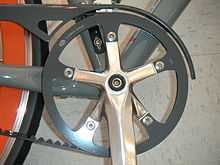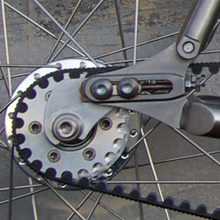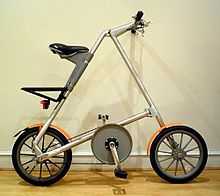Belt-driven bicycle





A belt-driven bicycle is a chainless bicycle that uses a toothed synchronous belt to transmit power from the pedals to the wheel. The belts are typically made by the same manufacturing companies that produce timing belts for automobiles, machinery, and other synchronous belt drive applications.
The application of belt drives to bicycles is growing, especially in the commuter bicycle market, due to the low maintenance and lubrication-free benefits. Belt drives are also available for stationary and fitness bicycles.[1]
Benefits
- Belts do not rust.
- Lubrication is not required.
- Cleanliness due to lack of lubrication.
- Little to no maintenance.
- Smoother operation. A belt's teeth completely engage into the system for decreased friction.[citation needed]
- Quieter than chain.[2][3]
- Longer life than metal bicycle chains.[4][5]
- Some belt systems are lighter than conventional chain driven system.[4][5]
Drawbacks
- Derailleurs cannot be used, so an internal-gear hub is used if multiple gear ratios are required.
- The belt cannot be taken apart as a chain can, so a frame must be able to accommodate the belt by having an opening in the rear triangle or an elevated chain stay.
- Belts come in limited length selection, one of which the frame must be designed to fit.
- Belt-driven bicycles and their repair or replacement parts are scarcer at shops than bicycles with conventional chain.
- Front and rear pulleys or sprockets must be well aligned to avoid excessive friction and wear. A chain is more flexible in this respect.[6]
- First-generation pulleys with dual guides had problems with snow becoming compacted and trapped in the pulley (up to complete inoperability in some cases). Second generation (one guide, wheel side) and third generation (center guide) improve upon the design. [citation needed]
History
The Bridgestone Picnica belt-drive bicycle was introduced in the early 1980s. It used a tooth-belt drive like auto timing belts and Harley-Davidson drive belts, along with a novel two-part chainring that increased belt tension with increasing load. The Picnica was a folding bicycle, and part of the appeal of the belt drive was cleanliness. The Picnica was a small wheel bicycle, so belt tension may have been less than on a bicycle with standard-size wheels. It was apparently successful, but was offered mainly in Japan.
Bridgestone did offer belt drive bicycles in the USA until they left the market about 1994. Since their innovation, they have continuously offered belt drive bicycles in Japan including their best selling Albelt model.
In 1984 and 1985, Mark Sanders, a designer who had earned his degree in Mechanical Engineering from Imperial College, London, designed a folding bicycle as part of his graduate studies in an Industrial Design Engineering (IDE) program. The program was run jointly by Imperial College and the Royal College of Art in London. He collaborated with a design engineer from Gates Corporation to outfit his bicycle with a belt, rather than a chain.
When his project was complete, Sanders chose entrepreneur and former Greg Norman manager James Marshall and a Glasgow manufacturer to turn his award-winning design into a product. The manufacturer coined the name STRiDA, and in 1987 the bicycle began rolling off the production line. In 2002 production was moved to Taiwanese manufacturer Ming Cycle in order to meet increased demand, and as of 2007, Ming Cycle fully owned the STRiDA brand and intellectual property rights.
iXi bicycles, distributed in the United States by Delta Cycle Corporation, followed in 2004 with a compact design that, like STRiDA, featured a belt drive. Other folding bike manufacturers that have implemented a belt drive include U.S. company Bike Friday and Netherlands-based Bernds.
In 2007, Gates Corporation developed a high-modulus synchronous belt and sprocket system called the Carbon Drive System. The belt’s pitch allowed for lower tension requirements to help prevent skipping. Lightweight, patent-pending sprockets have Mud Ports, openings under each tooth, which work to slough off debris. Early adopters who helped evaluate, revise and introduce this system included Frank Scurlock of Spot Brand Bicycles and Kalle Nicolai of Nicolai Ltd.
In 2009, an increasing number of bicycle companies, including Trek and f8 Cycles, offered belt-driven bicycles. While builders initially focused on single-speeds and internal hubs, in early 2009 f8 used a Gates-compatible fixed gear cog designed by Phil Wood & Co.,[7] offering a belt-driven fixed gear bicycle.
In 2010, Daimler introduced the Smart eBike, a power-electric hybrid bicycle featuring Gates Carbon drive belt system. The eBike is emission free and is designed for a clean, grease-free ride.[8] Other notable eBike brands include Grace and Pi-Mobility.
In 2011, Gates Corporation introduced CenterTrack, a new belt and pulley design that improves on the initial Carbon Drive System design. CenterTrack is more tolerant of misalignment than its predecessors. It also has narrower pulleys, making packaging with the latest generation of internally geared hubs much easier.[2][9]
The possibilities for belt-driven bicycles are increasing as manufacturers of internal gear hubs (gears inside the rear hub, which allow riders of belt-driven bicycles to shift easily) are constantly innovating and introducing new designs such as the Shimano Alfine 11 and Fallbrook Technologies’s NuVinci. Other major internally geared hub makers include SRAM, Sturmey-Archer and Rohloff.
Manufacturers
Notable manufacturers of belt-driven bicycles or belt drives include:
- Avanti
- BMC Trading — Lifestyle models Urban Challenge and Mass Challenge
- Bridgestone — Albelt, Beltrex
- Co-Motion Cycles — Americano, Pangea, CityView and Speedster (tandem) bicycle models
- Cycle Union
- Daimler – Smart eBike creators featuring Gates belt drive[10]
- Diamant
- Focus Bikes
- Gates Corporation — belt drive
- Raleigh
- REI — Novara
- Scott
- Specialized — Source 11 model
- Strida — a portable, folding bicycle
- Trek Bicycle Company — District and Soho bicycle models. Also under the Villiger brand.
See also
References
- ↑ "Freemotion Fitness Carbon Drive". Retrieved 2012-05-02.
- ↑ 2.0 2.1 "Building a Better Belt". Retrieved 2012-05-02.
- ↑ "Stuff We Like: Gates Carbon Drive Systems". Retrieved 2012-05-02.
- ↑ 4.0 4.1 "Gates Carbon Drive Systems". Retrieved 2009-08-05.
- ↑ 5.0 5.1 "Cycle Drive Systems: FAQ". Retrieved 2009-08-05.
- ↑ FAZ (german newspaper), July 11th 2011, Pardey: Spannend ist die richtige Spannung.
- ↑ "f8 Cycles: Function". Archived from the original on 30 January 2010. Retrieved 2010-02-09.
- ↑ "News from smart". Retrieved 2012-05-02.
- ↑ "Gates Carbon Drive Products". Retrieved 2012-05-02.
- ↑ "Daimler Begins Deliveries of smart Electric Bikes". EV World. 2012. Retrieved 2012-05-10. "The drive is also of a very high quality with a completely maintenance- and oil-free carbon toothed belt instead of a conventional bicycle chain."
External links
| Wikimedia Commons has media related to Belt-drive bicycles. |
